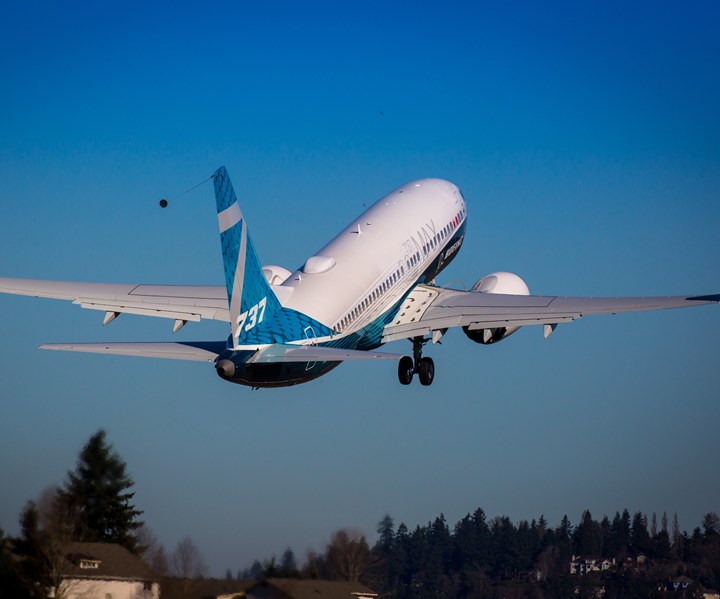The black swan events hitting the composites industry
From the Boeing 787 to COVID-19: When the out-of-the-ordinary becomes ordinary — and affects the manufacturing supply chain.

Boeing 737 MAX. Source | Boeing
It’s March 11 as I write this. One year and one day ago, on March 10, 2019, the world was hit by what turned out to be the first in a series of black swan events. Ethiopian Airlines flight 302 crashed shortly after take-off from Addis Ababa Bole International Airport in Addis Ababa, Ethiopia. Everyone onboard died.
The plane, of course, was a 737 MAX. As we all know, the crash precipitated the grounding of the entire global 737 MAX fleet of 387 aircraft, followed by the slowing and then stopping of 737 MAX production altogether in December 2019 (black swan #2). The aerospace supply chain, in the meantime, was thrown in disarray, with about 400 manufactured-but-not-delivered aircraft in storage by Boeing. Spirit AeroSystems (Wichita, Kan., U.S.), which makes the aluminum fuselage for the entire 737 product line, was forced to lay off 2,800 employees in January 2020. Hundreds of other Tier 2 and Tier 3 suppliers have been similarly impacted.
The harm done to the composites industry by the 737 MAX grounding has been, for the most part, indirect. Although there are some composites on the 737, they are mostly in the engines. The disruption we have felt is caused by 737 MAX ripples, as Boeing has committed vast resources to fixing the 737 MAX and getting it re-certified for flight. This has limited Boeing’s ability to focus on other projects.
Now is the time to prove the material capability, production capacity and technological aptitude required for next-generation aircraft.
Consider, for example, that prior to March 10, 2019, Boeing was on a path to announce sometime in 2019 the New Midsize Aircraft (NMA), a new twin-aisle, 200-270-seat, 4,000-5,000-nautical-miles range plane that would fit between the 737 MAX 10 and the 787-8 in the company’s lineup. The NMA, the thinking was, would provide a technological stepping stone for composite materials and process maturation, en route to development of a single-aisle replacement for the 737, Boeing’s most popular and most profitable aircraft. The NMA would have entered service around 2025, followed by a single-aisle replacement around 2030.
That plan, apparently, is on hold — at least until the 737 MAX is back in service. And the NMA may not come to fruition at all. Airbus, at the 2019 Paris Air Show, announced the A321XLR, a long-range version of the A321 that is designed to allow longer city-pair flights (i.e., Madrid-Dubai) in a single-aisle configuration. (Flying that far in a single-aisle aircraft may not sound appealing, but it definitely will be profitable.) Boeing, seeing the popularity of the A321XLR, is rethinking the NMA and might . . . what? Morph the NMA into an XLR derivation? Skip right to the single-aisle replacement? And if that occurs, what happens to the composites technology maturation we’d hoped for?
Airbus, for its part, is happy to watch Boeing struggle to bring the 737 MAX back to life and figure out next steps for the NMA/single-aisle replacement. It is assumed that Airbus will also develop a single-aisle replacement for the A320 (circa 2030 service date), depending in part on what path Boeing chooses. Airbus is pursuing, for a new single-aisle, several high-profile composites M&P development efforts, including an infused wing (Wing of Tomorrow) a thermoplastic fuselage (Clean Sky 2) and more.
… the world could see a 9% drop in passenger air travel as a result of COVID-19, which will put even more pressure on the economy in general and the aerospace supply chain in particular.
The aerospace composites supply chain is, of course, watching all of this anxiously. There is a great desire among raw material suppliers (carbon fiber, glass fiber, fabrics, resins, etc.), intermediates producers (weavers, braiders, prepreggers) and fabricators of finished parts and structures to be a part of the supply chain for next-generation aircraft. Now is the time to prove the material capability, production capacity and technological aptitude required for next-generation aircraft.
And then, of course, the black swan that is the 737 MAX was joined in January by the black swan that is COVID-19. Even as I write this, the virus has introduced such uncertainty into the global marketplace that air travel is depressed, schools have been closed, events (like JEC World 2020) have been postponed or canceled and the stock market has melted down (it’s down a whopping 5.9% today alone). Some air travel analysts suggest that the world could see a 9% drop in passenger air travel as a result of COVID-19, which will put even more pressure on the economy in general and the aerospace supply chain in particular. And no one knows how long it will be before normal returns.
But, normal will return. The 737 MAX will, gradually, return to
service. COVID-19 will fade, or at least become a part of the human
health landscape. New aircraft programs will be announced. And
even with future black swans the composites industry is still well-positioned for long-term growth.
Related Content
Who's ready for the Olympics?
With the 2024 Summer Olympics in Paris, this year’s JEC World is bound to be abuzz with talk of this year’s event — from the use of composites in sporting equipment to the roles they play in AAM.
Read MoreThe return of trade show season
SAMPE Seattle, JEC World and the Paris Air Show are approaching fast, and they signal the real emergence of a post-pandemic world.
Read MoreRemembering Don Adams
When one thinks of composites test methods, one thinks of Don Adams. Don passed away at the end of 2022. We remember him here.
Read MoreYour must-have composites industry guide for 2025
Welcome to CW’s annual SourceBook, your guide to suppliers of machinery, materials, software and other services for the composites industry.
Read MoreRead Next
All-recycled, needle-punched nonwoven CFRP slashes carbon footprint of Formula 2 seat
Dallara and Tenowo collaborate to produce a race-ready Formula 2 seat using recycled carbon fiber, reducing CO2 emissions by 97.5% compared to virgin materials.
Read MoreDeveloping bonded composite repair for ships, offshore units
Bureau Veritas and industry partners issue guidelines and pave the way for certification via StrengthBond Offshore project.
Read MoreVIDEO: High-volume processing for fiberglass components
Cannon Ergos, a company specializing in high-ton presses and equipment for composites fabrication and plastics processing, displayed automotive and industrial components at CAMX 2024.
Read More






















